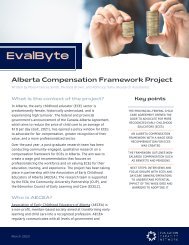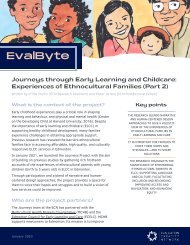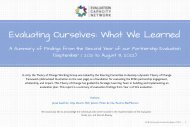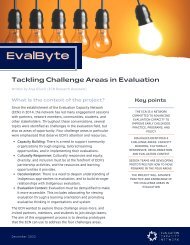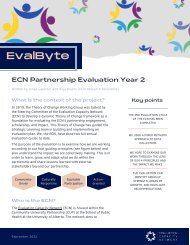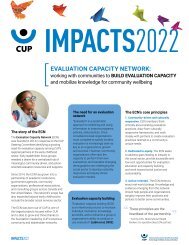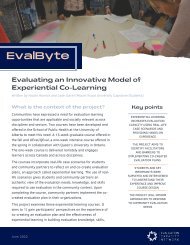Pursuing a Historic Urban Landscape Approach to Heritage in Edmonton
Create successful ePaper yourself
Turn your PDF publications into a flip-book with our unique Google optimized e-Paper software.
modern [heritage] charters… were developed dur<strong>in</strong>g this phase: the memory value of heritage, the right <strong>to</strong> aesthetic enjoyment, and<br />
collective responsibility for its conservation” (Bandar<strong>in</strong> and Van Oers, 2012: p.10)).<br />
Such values certa<strong>in</strong>ly cont<strong>in</strong>ue <strong>to</strong> resonate with concerns for heritage plann<strong>in</strong>g <strong>to</strong>day and are shared with<strong>in</strong><br />
many contemporary heritage approaches; however the modernist roots of heritage have also attracted critical<br />
attention, mirror<strong>in</strong>g wider postmodern shifts <strong>in</strong> social and political thought. A variety of alternates (see<br />
Appendix B) come forward <strong>in</strong> these critiques, draw<strong>in</strong>g <strong>in</strong>spiration from cultural geography, cultural landscape<br />
approaches (Taylor, 2015), value-based accounts of heritage (Mason & Avrami, 2002), and studies of liv<strong>in</strong>ghis<strong>to</strong>ry<br />
(Poulios, 2010; 2012; 2014). While nuanced and not always compatible with one another, these<br />
emergent models provide alternates <strong>to</strong> what is perceived as the narrow values and attributes ascribed <strong>to</strong><br />
heritage with<strong>in</strong> <strong>in</strong>stitutional plann<strong>in</strong>g and governance. They also exhibit greater reflexivity and attention <strong>to</strong><br />
issues of power, identity and participation. The follow<strong>in</strong>g list describes some further characteristics of<br />
contemporary heritage approaches:<br />
<br />
<br />
<br />
<br />
<br />
<br />
An emphasis on the heterogeneity and contested nature of heritage values, contrasted aga<strong>in</strong>st earlier<br />
attempts <strong>to</strong> create unified and authentic heritage narratives.<br />
A belief that contemporary heritage plann<strong>in</strong>g should support the <strong>in</strong>clusion of a wider range of<br />
community voices and heritage stakeholders than the systems of experts and society elites supported<br />
by the conservation movement (Sykes & Ludwig, 2015; Mason & Avrami, 2002).<br />
<strong>Heritage</strong> narratives are approached reflexively and <strong>in</strong> ways which are m<strong>in</strong>dful of context, as opposed <strong>to</strong><br />
be<strong>in</strong>g accepted as static, abstracted, or taken-for-granted.<br />
That heritage (<strong>in</strong>clud<strong>in</strong>g who and what is def<strong>in</strong>ed as significant) is a process and the consequence of<br />
social activity (see Taylor, 2015).<br />
That heritage has <strong>to</strong> be unders<strong>to</strong>od across the boundaries of past, present and future.<br />
That the conservation of the material past is best supported by l<strong>in</strong>k<strong>in</strong>g conservation <strong>to</strong> social and<br />
cultural heritage values (Van Oers, 2014; Mason & Avrami, 2002).<br />
Open<strong>in</strong>g up the boundaries of heritage can be challeng<strong>in</strong>g as it suggests the need <strong>to</strong> address a greater degree of<br />
social and cultural complexity <strong>in</strong> the approaches of planners and heritage advocates. What might seem like a<br />
lack of cohesiveness, however, should not be taken <strong>to</strong> imply that evolv<strong>in</strong>g heritage approaches are less<br />
mean<strong>in</strong>gful. Instead, the ideas above suggest that the robustness of heritage approaches is achieved through<br />
reflexivity 3 as opposed <strong>to</strong> be<strong>in</strong>g <strong>in</strong>herent <strong>in</strong> heritage objects or narratives themselves. Simply, urban heritage is<br />
given mean<strong>in</strong>g through struggles over def<strong>in</strong>itions of value, and determ<strong>in</strong><strong>in</strong>g the practical means of mak<strong>in</strong>g<br />
heritage mean<strong>in</strong>gful for current and future communities of citizens.<br />
Beyond the Rational City<br />
Along similar trajec<strong>to</strong>ries, the orig<strong>in</strong>s of HUL reflect trends <strong>in</strong> urban studies and scholarly approaches <strong>to</strong> the<br />
social and cultural understand<strong>in</strong>g of cities. Aga<strong>in</strong>, tak<strong>in</strong>g liberty with the immense depth of urban studies over<br />
the past half-century (at least), the shift follows a critique of modernist approaches <strong>to</strong> city-build<strong>in</strong>g and their<br />
emphasis on rational and progressive plann<strong>in</strong>g logics. From Haussmann’s attempt <strong>in</strong> the n<strong>in</strong>eteenth century <strong>to</strong><br />
“bludgeon” (Harvey, 2005: 3) medieval Paris <strong>in</strong><strong>to</strong> a modern city, through Le Corbusier’s and Moses’s early<br />
twentieth century attempted <strong>to</strong> design the modern city through u<strong>to</strong>pic planned communities of skyscrapers,<br />
grand parks, and car-centric cities of expressways and suburbs. Modernist plann<strong>in</strong>g approached the city as a<br />
rational object requir<strong>in</strong>g the shap<strong>in</strong>g of professional adm<strong>in</strong>istra<strong>to</strong>rs, eng<strong>in</strong>eers and developers. Architectural<br />
3 Van Assche et al. (2016: p.230) def<strong>in</strong>e reflexivity as: “the habit and attitude <strong>to</strong> reflect on one’s actions, thoughts and<br />
positions, and <strong>to</strong> look for ground<strong>in</strong>g assumptions, underly<strong>in</strong>g discourses and their effects.”<br />
4




